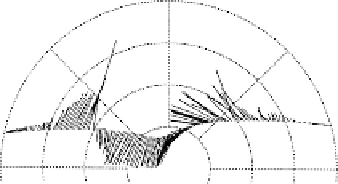Geoscience Reference
In-Depth Information
DE-B Ion drift velocities
MLT v ILAT
Northern Hemisphere
B
x
51
3.5
B
y
522.0
B
z
52
12
0.2
15
9
18
6
B
x
510.3
B
y
51
3.7
B
z
520.5
12
15
9
18
6
1 km/sec
(d)
Figure 8.8d
Measurements of the vector plasma drift velocity in the dayside high-latitude
ionosphere show that the antisunward flow can be preferentially biased toward the dawn
or dusk directions depending on the sign of
B
y
. (Parts (b)-(d) courtesy of R. A. Heelis
and W. B. Hanson.)
side of the noon-midnight meridian and are of equal size. When
B
y
is positive, the
clockwise circulation in the high-latitude dawn cell tends to expand into the dusk
side, and the anticlockwise cell virtually disappears. Expansion of the dawn cell
is apparent as
B
y
becomes positive. The lower-latitude convection cells circulate
in the manner expected during a southward IMF. Their geometry and position
show no strong dependence on the IMF
y
component and the total potential
drop across these cells rarely exceeds 10 kV. It may well be that this part of the
convection pattern is driven by the viscous interaction described earlier.
These patterns correspond to a steady state, which is probably never attained.
One experiment has revealed how the polar cap dynamically changes from
B
z
south to
B
z
north. Three rockets were flown during just such a transition. It is well
known that the polar cap shrinks when
B
z
turns north. These data suggest that
this occurs when an auroral arc surges sunward, bringing sunward convection
behind it. Figure 8.13 shows the convection pattern along a flight trajectory
of one rocket directed toward the southeast. As the arcs surged sunward at




Search WWH ::

Custom Search